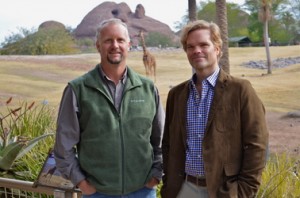View Source | January 17, 2014

Modern, professionally managed zoos frequently serve as global conservation agents – working to save species, educate the public about species loss and recovery, practice conservation breeding and reintroduce animals into the wild. These important efforts depend on understanding the scientific complexities of the animals and their habitats, as well as the history, ethics and policies that often deeply impact animal survival.
Arizona State University’s School of Life Sciences and the Phoenix Zoo are launching a new program to strengthen animal conservation efforts by collaborating on new research and improving conservation communications and outreach to the public.
In addition, the School of Life Sciences recently named Ben Minteer, an associate professor, as its Arizona Zoological Society Chair. Robert E. Maytag established this chair position in 1961, around the time he became founding president of the Arizona Zoological Society and conceived of what is now the Phoenix Zoo. In this role, Minteer will engage in a multi-year project focused on the science, ethics and history of zoo conservation.
“This is a fantastic opportunity for both institutions to work together on some new and exciting directions,” said Minteer. “We can infuse our research at ASU with the concerns that Phoenix Zoo conservationists and management raise, and enrich their work with our expertise in conservation science and the history and development of zoos in society.”
Zoo president and CEO Norberto J. “Bert” Castro sees this relationship as a natural fit. “Conservation and education are core to the Zoo’s mission. Like all nonprofits in this day and age, we must seek out partnerships that allow us to magnify our impact,” said Castro. “Teaming up with ASU’s School of Life Sciences in this new collaboration promises to do just that.”
Collaborative conservation research
For the first time, the two organizations are jointly supporting a new Conservation Research Post-doctoral Fellow position. Jan Schipper begins working this month in a shared capacity with the zoo and the university. Schipper spent years completing a global conservation assessment of the world’s mammals for the IUCN’s Red List of Threatened Species and has contributed to field studies on a wide variety of species.
“This is a great opportunity to develop a conservation research program focused on local and international species threatened with extinction,” shared Schipper. “This new partnership can foster a legacy of bringing the best science to bear on decision-making. Both institutions are engaged in research, education and conservation, so it’s a unique opportunity to help build a foundation for what is sure to become a dynamic and long-term conservation partnership.”
Schipper, whose position is funded in part from philanthropic donations, will develop a conservation research project that connects the research community in the school to conservation professionals and managers at the zoo. He will also contribute to the zoo’s education and outreach efforts, sharing engaging stories about the importance of animal conservation. In addition, this partnership will provide new ways for ASU undergraduate and graduate students to be directly involved in research at the zoo.
Local and international focus on threatened species
For more than 50 years, the Phoenix Zoo has been a global leader in conservation in some high profile cases, including preserving the black-footed ferret, the Chiricahua leopard frog and the Arabian Oryx. The zoo is re-doubling its conservation efforts, which provides an important platform for researchers.
“I have a number of existing projects in Costa Rica and Colombia involving threatened species, many of which are small populations that require research and successful on-the-ground conservation efforts,” explained Schipper. “These include mammals such as the jaguar, Dice's cottontail and a newly discovered harlequin frog population. Closer to home, I will develop research questions around threatened species in Arizona.”
“The Phoenix Zoo is home to more than 1,400 animals. We take seriously our responsibility to ensure that the animals in our care are ambassadors for their wild counterparts,” said Ruth Allard, the zoo’s executive vice president for conservation and visitor experiences. “We do this through long-term collaboration with wildlife agencies on native species recovery and through partnerships with scientists worldwide. Having Jan directly linked with the zoo allows us to even more directly contribute to finding solutions to real-world conservation problems.”
Conservation events
Minteer’s work will focus more on the historical and ethical dimensions of zoo conservation. He and his colleagues in the Center for Biology and Society at ASU are developing a multi-year research, education and public program on the subject.
“I’m really interested in zoo history, as well as the ethical and policy challenges of biodiversity conservation and the role of zoos in that global effort,” shared Minteer. “Zoos are remarkably complex and fascinating institutions – how did they develop over time, and how and why have they deepened their conservation mission in recent decades? Understanding the complexities involved with zoos and conservation will certainly add to our ability to improve both conservation research and animal management.”
The first scheduled event at ASU is a free screening of the film “Green Fire: Aldo Leopold and a Land Ethic for Our Time.” The event, featuring creative film director and Leopold expert Curt Meine, is set for Jan. 23 at 5:30 p.m., and is co-hosted by ASU School of Life Sciences, the Phoenix Zoo and ASU Global Institute of Sustainability. Reserve your seat here.
ASU School of Life Sciences is an academic unit of ASU College of Liberal Arts and Sciences

